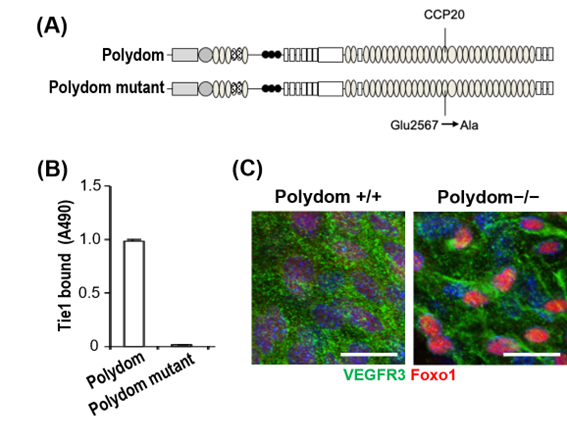![]()
ACHIEVEMENTSIPR The University of Osaka
-

- ACHIEVEMENTS
- Toward a better understanding of lymphatic system remodeling
Press Release
2023.06.21
Toward a better understanding of lymphatic system remodeling
Researchers from Osaka University identify an important role of the proteins Polydom and Tie1 in cell migration during lymphatic system remodeling
Osaka, Japan – Lymphangiogenesis refers to the formation and remodeling of lymphatic vessels (a network of thin tubes that carry lymph in the lymphatic system), and it supports the transport of molecules and immune cells around the body. Recently, a team led by researchers at Osaka University has uncovered important insights into lymphatic cell migration and lymphatic vessel remodeling.
Polydom (or SVEP1) is a kind of protein that is essential for making new lymphatic vessels; this is known because mice that do not express this protein have problems with lymphatic development and do not survive after birth. However, not much is known about how this protein works in lymphangiogenesis, so the research team investigated this further. They identified that the binding of Polydom with another protein, Tie1, is important for lymphatic cell migration in lymphangiogenesis.
“We know that another protein, a receptor known as Tie1, is also important in the formation of lymphatic vessels, but it was unknown what proteins bind to Tie1 and, subsequently, which downstream signaling pathways they activate,” explains lead author of the study Ryoko Sato-Nishiuchi. “Because mice lacking either Tie1 or Polydom have similar problems, we decided to investigate whether Tie1 and Polydom might interact in some way, to see how this relates to the process of lymphangiogenesis.”
The research team first used a technique called solid-phase binding assay to show that Tie1 binds to Polydom. They then placed lymphatic endothelial cells (one of the key cell types that make up lymph vessels) into a special system to track cell migration, and found that both Tie1 and Polydom—but not other similar kinds of proteins—were essential for the migration of these cells.
“We were then able to identify some of the downstream pathways, such as the PI3K/Akt pathway and FoxO1 signaling, that are also important in the lymphatic endothelial cell migration induced by Tie1/Polydom,” says senior author of the study Kiyotoshi Sekiguchi. “Our finding that the binding of Polydom and Tie1 facilitates lymphatic vessel remodeling by modulating the PI3K/Akt signaling pathway in lymphatic endothelial cells is important for understanding how lymphangiogenesis works.”
A better understanding of lymphangiogenesis will aid in the development of treatments for diseases or injuries of the lymphatic system, such as lymphedema, which has no curative treatment. This disease can be genetic, and also commonly develops in cancer patients. Better treatments for lymphedema, as well as other lymph-related diseases, will improve the quality of life for many patients.
###
The article, “Polydom/SVEP1 binds to Tie1 and promotes migration of lymphatic endothelial cells,” was published in Journal of Cell Biology at DOI: https://doi.org/10.1083/jcb.202208047
Summary: Researchers from Osaka University found that the binding of two proteins—Polydom and Tie1—is essential for lymphatic cell migration in the remodeling of lymphatic vessels, which transport molecules around the body. A better understanding of the development and remodeling of the lymphatic system will lead to better therapeutic options for diseases such as lymphedema, which is common in cancer patients and currently has no cure.
Tweet: A better understanding of lymphatic vessel remodeling may lead to improved treatment for lymphedema, a common and incurable disease in cancer patients
Tweet 2: Better together? Research from Osaka University indicates that the binding of two proteins, Tie1 and Polydom, is key for lymphatic vessel remodeling
Primary Keyword: Life sciences
Additional Keywords: Cell biology, Molecular biology, Developmental biology, Lymphatic system, Lymph, Endothelial cells, Cell migration

Fig. 1
Polydom binds to Tie1 and activates the PI3K/Akt signaling pathway.
(A) The domain structure of Polydom and its mutant protein. (B) Tie1 binds to Polydom, but not to its mutant. (C) Lymphatic endothelial cells of wild-type (left) and Polydom-deficient (right) mice. The PI3K/Akt pathway is inactivated in the lymphatic cells of Polydom-deficient mice.
License: Original content
Usage restriction: Credit must be given to the creator. No modifications of the work are permitted.
Credit: Kiyotoshi Sekiguchi
Title: Polydom/SVEP1 binds to Tie1 and promotes migration of lymphatic endothelial cells
Journal: Journal of Cell Biology
Authors: Ryoko Sato-Nishiuchi, Masamichi Doiguchi, Nanami Morooka and Kiyotoshi Sekiguchi
DOI: 10.1083/jcb.202208047
Funded by:
Japan Society for the Promotion of Science
Ministry of Education, Culture, Sports, Science and Technology
Osaka University by Nippi, Inc.
About Osaka University
Osaka University was founded in 1931 as one of the seven imperial universities of Japan and is now one of Japan’s leading comprehensive universities with a broad disciplinary spectrum. This strength is coupled with a singular drive for innovation that extends throughout the scientific process, from fundamental research to the creation of applied technology with positive economic impacts. Its commitment to innovation has been recognized in Japan and around the world, being named Japan’s most innovative university in 2015 (Reuters 2015 Top 100) and one of the most innovative institutions in the world in 2017 (Innovative Universities and the Nature Index Innovation 2017). Now, Osaka University is leveraging its role as a Designated National University Corporation selected by the Ministry of Education, Culture, Sports, Science and Technology to contribute to innovation for human welfare, sustainable development of society, and social transformation.
Website: https://resou.osaka-u.ac.jp/en






